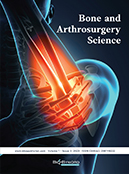Abstract
Objective: To analyze the effect of ulnar styloid process fracture types on the treatment of distal radius fracture. Methods: A total of 49 patients with distal radius fractures admitted to the hospital between December 1, 2018 and November 30, 2022 were selected. Among the patients, 26 of them were complicated with type I ulnar styloid fracture (the first group), and 23 patients were complicated with type II ulnar styloid fracture (the second group), and were treated with open reduction and internal fixation using Kirschner wire and tension band. The total effective rate, anatomical indicators such as palm inclination and ulnar deviation, and the range of motion of the wrist joint were compared between the two groups. Results: The total effective rate of the first group was higher than that of the second group (P < 0.05). There was no difference in anatomical indicators between the groups before operation and 3 months after operation (P > 0.05). Before operation, there was no difference in the range of motion of the wrist joint between the groups (P > 0.05). 3 months after operation, the range of motion of the wrist joint in the first group was greater than that in the second group (P < 0.05). Conclusion: The types of ulna styloid fracture can affect the effectiveness of treatment and joint mobility of distal radius fracture.
References
Nakamura T, Moy OJ, Peimer CA, 2021, Relationship Between Fracture of the Ulnar Styloid Process and DRUJ Instability: A Biomechanical Study. Journal of Wrist Surgery, 10(2): 111–115.
Cha SM, Shin HD, Lee SH, et al., 2021, Factors Predictive for Union of Basal Fracture of the Ulnar Styloid Process After Distal Radial Fracture Fixation Using a Volar Locking Plate. Injury, 52(3): 524–531.
Korhonen L, Victorzon S, Serlo W, et al., 2019, Non-Union of the Ulnar Styloid Process in Children is Common but Long-Term Morbidity is Rare: A Population-Based Study with Mean 11 Years (9–15) Follow-Up. Acta Orthopaedica, 90(4): 383–388.
Patrick NC, Lewis GS, Roush EP, et al., 2020, Biomechanical Stability of Volar Plate Only Versus Addition of Dorsal Ulnar Pin Plate: A Dorsal Ulnar Fragment, C-3-Type, Distal Radius, Cadaver Fracture Model. Journal of Orthopaedic Trauma, 34(9): E298–E303.
Andrade-Silva FB, Rocha JP, Carvalho A, et al., 2019, Influence of Postoperative Immobilization on Pain Control of Patients with Distal Radius Fracture Treated with Volar Locked Plating: A Prospective, Randomized Clinical Trial. Injury, 50(2): 386–391.
Hollenberg AM, Hammert WC, 2022, Minimal Clinically Important Difference for PROMIS Physical Function and Pain Interference in Patients Following Surgical Treatment of Distal Radius Fracture. Journal of Hand Surgery (American Volume), 47(2): 137–144.
Heyer FL, De Jong JJA, Willems PC, et al., 2021, The Effect of Bolus Vitamin D-3 Supplementation on Distal Radius Fracture Healing: A Randomized Controlled Trial Using HR-pQCT. Journal of Bone and Mineral Research, 36(8): 1492–1501.
Yamak K, Karahan HG, Karatan B, et al., 2020, Evaluation of Flexor Pollicis Longus Tendon Rupture After Treatment of Distal Radius Fracture with the Volar Plate. Journal of Wrist Surgery, 9(3): 219–224.
Tarabin N, Gehrmann S, Mori V, et al., 2020, Assessment of Articular Cartilage Disorders After Distal RadiusFracture Using Biochemical and Morphological Nonenhanced Magnetic Resonance Imaging. Journal of Hand Surgery (American Volume), 45(7): 619–625.
Georgiadis AG, Burgess JK, Truong WH, et al., 2020, Displaced Distal Radius Fracture Treatment: A Survey of POSNA Membership. Journal of Pediatric Orthopaedics, 40(9): E827–E832.
Isobe F, Yamazaki H, Hayashi M, et al., 2019, Prospective Evaluation of Median Nerve Dysfunctions in Patients with a Distal Radius Fracture Treated with Volar Locking Plating. The Journal of Hand Surgery (Asian-Pacific Volume), 24(4): 392–399.
Saka N, Nomuraz K, Amano H, et al., 2020, Coding and Prescription Rates of Osteoporosis Are Low Among Distal Radius Fracture Patients in Japan. Journal of Bone and Mineral Metabolism, 38(3): 363–370.
Shim BJ, Lee MH, Lim JY, et al., 2021, A Longitudinal Histologic Evaluation of Vitamin D Receptor Expression in the Skeletal Muscles of Patients with a Distal Radius Fracture. Osteoporosis International, 32(7): 1387–1393.
Sa-Ngasoongsong P, Rohner-Spengler M, Delagrammaticas DE, et al., 2020, Comparison of Fracture Healing and Long-Term Patient-Reported Functional Outcome Between Dorsal and Volar Plating for AO C3-Type Distal Radius Fractures. European Journal of Trauma and Emergency Surgery, 46(3): 591–598.
Chung KC, Kim HM, Haase SC, et al., 2019, Predicting Outcomes After Distal Radius Fracture: A 24-Center International Clinical Trial of Older Adults. Journal of Hand Surgery (American Volume), 44(9): 762–771.
